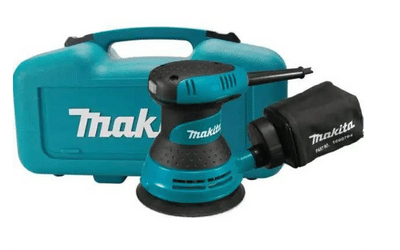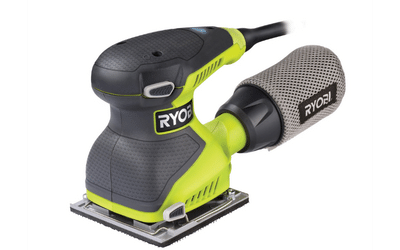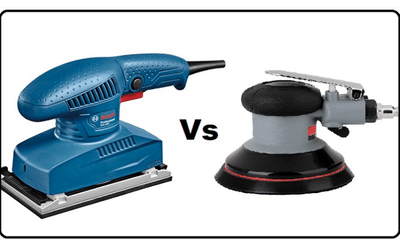Orbital sanders and sheet sanders are among the most common power sanders. They make sanding easier, gliding over wood surfaces effortlessly thanks to powerful motors.
Moreover, both are available in compact, lightweight models that you can handle with one hand.
Unfortunately, choosing between the two is often difficult as they offer nearly the same benefits. Indeed, they almost look alike. So, how do you distinguish the two, and which is better? Let’s find out.
Orbital Sander Vs Sheet Sander: What’s the Difference?
The main difference between orbital and sheet sanders is that while sheet sanders use sheets of sandpaper as abrasives, orbital sanders use special sanding disks. Additionally, orbital sanders offer greater flexibility, such as the ability to reach hard-to-reach areas. Meanwhile, sheet sanders are more affordable.
What’s an Orbital Sander
An orbital sander is a hand-held power sander that sands in circular or orbital motion. It uses special circular disks that rotate elliptically to create a smooth surface or remove paint or varnish from surfaces.
The term is often used interchangeably with the random orbital sander (RO sander). They are technically the same, except that random orbital sanders move randomly rather than in a pre-defined direction.
The RO sanding disc is typically 5.0 inches in diameter and available in various grit sizes. It attaches to the sanding machine via a hook-and-loop method or pressure-sensitive adhesive and often features tiny dust collection holes.
Though more expensive than standard rotary sanders, orbital sanders have no equal when it comes to versatility. They prove invaluable in multiple applications, from smoothing wood to paint stripping and sanding between paint coats.
How does Orbital Sanders work?
Orbital sanders are vibrating power tools comprising a ball-bearing mechanism that allows the circular sanding pad to rotate in a circular motion. Meanwhile, random orbital sanders move randomly and thus don’t repeat the sanding pattern over a given area, reducing the risk of swirl marks.
The “random” in RO sanders means you can move it in any direction without damaging the surface. For instance, you can move the sander along or across the grain.
Pros and Cons of Orbital Sanders
PROS
- Less visible cross-grain sanding
- Removes material fast
- Excellent dust collection
CONS
- The sanders are expensive
- The sanding discs are expensive
What’s an Orbital Sander used for?
- General woodworking applications
- Preparing surfaces before and after painting
- Stripping off paint and varnish
- Sanding drywall
- Polishing wood projects

What’s a Sheet Sander?
A sheet sander, as the name suggests, is a power sander that uses regular sandpaper sheets rather than sanding discs. The ¼-inch sheet is particularly common.
A spring-loaded clamp device holds the sandpaper sheets on the square sanding pad, which moves back and forth to remove surface material.
A sheet sander is also known by other names like palm sander, quarter-sheet pad sander, or finish sander.
How does a Sheet Sander work?
Sheet sanders move back and forth while simultaneously making tiny circular motions to ensure a smooth finish. A built-in motor facilitates both movements, typically at adjustable speeds.
So, you can increase the speed to hasten the sanding.
Pros and Cons of Sheet Sanders
PROS
- Better suited for sharp corners
- It’s more affordable than other sanders
- Sheet sandpaper is more cost-effective
CONS
- Sheet sanders produce scratch marks
- They aren’t very flexible; you must use them in a specified direction
What’s a Sheet Sander used for?
- Sand and smooth wood surfaces
- Sanding other materials, such as metal and plastic
- Paint removal

Random Orbital Sander Vs Sheet Sander: Head-to-Head
Are you still undecided between the two sander types? The following head-to-head comparison should make selection a little easier.
Motion
The type of motion is the most significant distinction between the two sander types. Both the sheet sander and orbital sander vibrate in a back-and-forth pattern to remove material. However, the direction in which you can guide the sander varies.
Sheet sanders are exclusively back-and-forth power tools. You can move the sander forward and backward, but not sideways or in circular patterns.
On the other hand, orbital sanders move in circular motions, too, while random orbital sanders move in any direction, thus the name “random.” So, you can move the sander left, right, back, or front.
Abrasive type
It’s easy to notice the differences in the abrasive types. Sheet sanders use rectangular sanding sheets that attach to a rectangular sanding pad.
If you take time to inspect the sanding sheets, you’ll notice that they are typically hard paper backings with abrasives on the sanding face.
Meanwhile, orbital sanders use circular sanding disks mounted on a circular sanding surface. Sanding discs have stronger backing material for increased durability.
The abrasive attachment method also differs. Whereas a spring-loaded system holds sheet sander abrasives in place, orbital and random orbit sanders use hook-and-loop attachment methods.
Scratch pattern
Unfortunately, this is where sheet sanders lose out. Their back-and-forth motion may leave swirl marks that compromise the project’s quality.
It’s particularly a big problem for high-accuracy woodworking projects. Moreover, you may have to go over swirl marks a few times to minimize their appearance, potentially slowing you down.
On the other hand, orbital and random orbital sanders leave no sanding marks. They combine circular motion with random elliptical movements to eliminate swirl marks and similar issues.
Therefore, orbital sanders produce “finer” work with smoother surfaces. This is critical for fine woodworking.
Unique features
A key distinguishing feature between orbital and sheet sanders is the dust collection system. Orbital sanders connect to vacuum systems for automatic sanding duct removal. More importantly, the sanding discs feature holes to facilitate dust removal.
Unfortunately, sheet sanders lack these critical features. Therefore, you must periodically stop to remove the sanding dust manually.
Dust accumulation and manual removal have many downsides. It slows you down, increases the risk of overheating, which may burn your hands and the wood surface, and also increases machine wear and tear.
Related read: Top dust collectors for small shops.
Ease of use
Both orbital and sheet sanders are easy to use. For instance, they work much faster than manual sanders and cover more surface area than palm sanders. However, random orbit sanders are a little easier to use than sheet sanders.
First, consider that the standard RO sander is a one-handed tool. This frees up your weaker hand to support the project for greater control and precision.
Also, a one-handed operation makes it easier to move around and tackle the wood surface more evenly. Though sheet sanders move faster, RO sanders are more efficient for two reasons.
First, automatic dust collection eliminates the need to stop and manually collect sanding dust. Also, fewer sanding marks mean fewer sanding rounds.
Cost
Sheet sanders are significantly more affordable than RO sanders. First, an orbit sander costs less upfront.
You’ll pay less than half the price to acquire a similarly rated sheet sander. Additionally, sheet sander sandpaper is very cheap compared to orbit sander sanding discs.
But you may want to consider a few additional factors. For instance, while a regular sheet sander is cheap, advanced sheet sander models with variable speed functions and hook-and-look sandpaper attachments are pricey.
Additionally, sheet sandpaper isn’t exactly cheap when you must replace it every few minutes. On the other hand, sanding discs can get you through several sanding tasks.
Versatility
An orbit sander is more versatile than a sheet sander. You only need to look at the range of applications to appreciate its versatility.
For instance, besides wood smoothing and prepping, you can use an orbital sander for paint stripping on various surfaces. Also, you can use it to brighten headlamps.
Additionally, you can use an orbital sander to sand between paint coats, sand drywall, and for polishing projects.
Unfortunately, sheet sanders aren’t as versatile. Yes, you can use them to sand plastic and metal surfaces besides wood. But the list ends there.
Sheet Sander Vs Orbital Sander for Furniture
Both sheet sanders and random orbital sanders are good for furniture projects. However, the suitability depends on the type of project.
For instance, a random orbital sander is the better choice for detail work, whereas sheet sanders handle corners better. Also, random orbital sander sanders handle smaller projects better, while sheet sanders are more suited to medium-scale work.
Orbital Sander Vs Random Orbital Sander
An orbital sander and a random orbital sander are similar in nearly every aspect. The only difference is that orbital sanders move in circular orbital motion while random orbit sander moves in orbital motion while randomly vibrating.
Therefore, a random orbital sander leaves fewer swirl marks.
Orbital Sander Vs Palm Sander
The random orbital sander and palm sander are used interchangeably in many applications. However, they differ slightly.
Random orbit sanders are more powerful and robust, thus fitting a wider range of uses, including paint removal. Meanwhile, palm sanders are low-power tools primarily designed to eliminate minor imperfections on wood surfaces.
Orbital Sander Vs Palm Sanders
Palm sanders are compact power sanding tools for removing minor imperfections on wood surfaces. They are exceptionally fast. However, they are small to enable single-hand operation.
So, they are ill-suited for large projects. Contrastingly, orbit sanders are medium-sized power sanders for medium to large projects. Also, orbit sanders require both hands on the tool.
Sheet Sander vs Belt Sander
Sheet sanders are significantly different from belt sanders. First, belt sanders are typically larger and more powerful, thus ideal for medium and large projects.
But more importantly, sheet sanders use rectangular sandpaper sheets on rectangular sanding pads. Meanwhile, belt sanders feature a continuous loop of sandpaper that rotates over two motor-operated drums.
When comparing tools like these, it’s essential to consider your project’s scale and requirements. For smaller tasks, a best smallest belt sander might be more suitable, while belt sanders excel in larger, more demanding applications.
Orbital Sander Vs Belt Sander
Orbit sanders are completely different from belt sanders. First, orbit sanders employ sanding discs, while belt sanders use sheet sandpaper.
Also, whereas the orbit sander’s disc is round and attached to a circular sanding pad, a belt sander employs a looping sandpaper band that runs over two motor-powered drums.
Orbital Sander Vs Mouse Sander
Mouse sanders are technically orbit sanders. However, they are slightly different from the regular orbit sander.
First, it has a triangular-shaped head (thus the name “mouse” sander). This unique head allows it to get into tight areas easily.
Additionally, it accepts multiple attachments, including “rubber” bits, for increased versatility. That said, orbit sanders are more powerful.
Read Also: Best Oscillating Belt and Spindle Sander
FAQs
Which is better; orbital sander or sheet sander?
Orbit sanders are slightly better than sheet sanders, and the prices reflect their superiority. For one, orbital sanders are more versatile. You can use the sander on multiple applications, from wood smoothing to paint removal. Additionally, an orbit sander leaves fewer swirl marks for a superior finishing job.
What is a sheet sander good for?
Sheet sanders are best for smoothing and preparing wood surfaces. That’s what they do best. Nonetheless, you can use the sanding tool to sand other materials like metal and plastic. Note, however, that you need different sandpapers for different materials.
Which type of sander is best?
Random orbital sanders are the best power sanders, all factors considered. First, they move in a random circular motion, minimizing the risk of sanding marks. Additionally, newer random orbital sander models offer variable speed control for high precision. Use progressively finer grits for the best results.
What is the advantage of an orbital sander?
The main advantage of an orbital sander is it leaves fewer sanding marks. This is especially true for random orbit sanders which employ a random motion to minimize or avoid swirl marks. In addition, orbital sanders are versatile tools that you can use for many other applications, including paint removal and restoring headlight transparency.
Also Read: Benchtop Belt Sander Reviews
Verdict
Orbital sanders and modern sheet sanders are some of the best power sanders when shifting from hand sanding. Both are powerful and highly efficient. Also, both are cost-effective. Nevertheless, they’re different.
When to Use an Orbital Sander: An orbital sander makes sense when working on a medium-to-large project that requires precision, with minimal or no sanding marks. It’s also great if you want a versatile tool with many applications.
When to Use Sheet Sanders: Sheet sanders are great if you desire an affordable power sander to get through small woodworking projects.
Interesting read: Best Sander for Doors.

